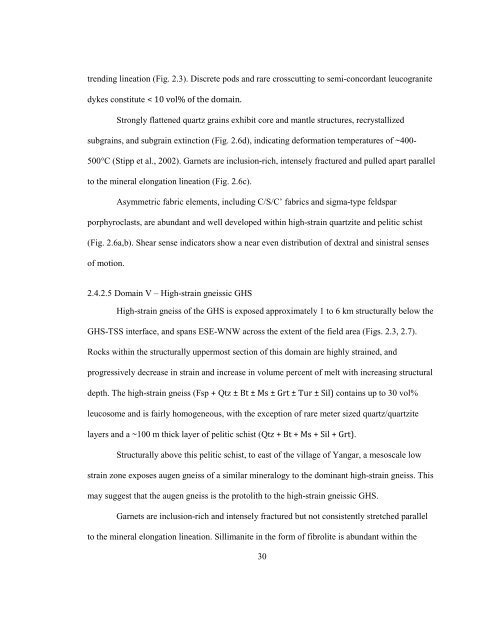title of the thesis - Department of Geology - Queen's University
title of the thesis - Department of Geology - Queen's University
title of the thesis - Department of Geology - Queen's University
You also want an ePaper? Increase the reach of your titles
YUMPU automatically turns print PDFs into web optimized ePapers that Google loves.
trending lineation (Fig. 2.3). Discrete pods and rare crosscutting to semi-concordant leucogranite<br />
dykes constitute < 10 vol% <strong>of</strong> <strong>the</strong> domain.<br />
Strongly flattened quartz grains exhibit core and mantle structures, recrystallized<br />
subgrains, and subgrain extinction (Fig. 2.6d), indicating deformation temperatures <strong>of</strong> ~400-<br />
500°C (Stipp et al., 2002). Garnets are inclusion-rich, intensely fractured and pulled apart parallel<br />
to <strong>the</strong> mineral elongation lineation (Fig. 2.6c).<br />
Asymmetric fabric elements, including C/S/C’ fabrics and sigma-type feldspar<br />
porphyroclasts, are abundant and well developed within high-strain quartzite and pelitic schist<br />
(Fig. 2.6a,b). Shear sense indicators show a near even distribution <strong>of</strong> dextral and sinistral senses<br />
<strong>of</strong> motion.<br />
2.4.2.5 Domain V – High-strain gneissic GHS<br />
High-strain gneiss <strong>of</strong> <strong>the</strong> GHS is exposed approximately 1 to 6 km structurally below <strong>the</strong><br />
GHS-TSS interface, and spans ESE-WNW across <strong>the</strong> extent <strong>of</strong> <strong>the</strong> field area (Figs. 2.3, 2.7).<br />
Rocks within <strong>the</strong> structurally uppermost section <strong>of</strong> this domain are highly strained, and<br />
progressively decrease in strain and increase in volume percent <strong>of</strong> melt with increasing structural<br />
depth. The high-strain gneiss (Fsp + Qtz ± Bt ± Ms ± Grt ± Tur ± Sil) contains up to 30 vol%<br />
leucosome and is fairly homogeneous, with <strong>the</strong> exception <strong>of</strong> rare meter sized quartz/quartzite<br />
layers and a ~100 m thick layer <strong>of</strong> pelitic schist (Qtz + Bt + Ms + Sil + Grt).<br />
Structurally above this pelitic schist, to east <strong>of</strong> <strong>the</strong> village <strong>of</strong> Yangar, a mesoscale low<br />
strain zone exposes augen gneiss <strong>of</strong> a similar mineralogy to <strong>the</strong> dominant high-strain gneiss. This<br />
may suggest that <strong>the</strong> augen gneiss is <strong>the</strong> protolith to <strong>the</strong> high-strain gneissic GHS.<br />
Garnets are inclusion-rich and intensely fractured but not consistently stretched parallel<br />
to <strong>the</strong> mineral elongation lineation. Sillimanite in <strong>the</strong> form <strong>of</strong> fibrolite is abundant within <strong>the</strong><br />
30

















